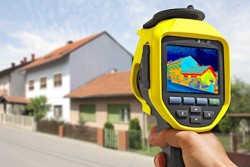The information collected during the survey can be fed back into the design process and further improvements can be made in future iterations of the product. In this way, these diagnostic tools can be used not only to maximise the energy efficiency of the current building but can also be used to improve the design and construction process of future projects as well.
Demonstrating Effectiveness
8th April, 2020

Joe Mazzon, Research Engineer at BSRIA outlines some of the ways that thermal imaging can improve energy efficiency in building design.
It is well known that buildings account for approximately 40% of the total energy we use. Based on this statistic, even a small improvement in energy efficiency in our buildings could have a huge impact on the environment.
A reduction in the amount of heat that escapes through a building envelope is one of the most important aspects of energy-efficient building design. Keeping the heat within the confines of the conditioned area removes the necessity to supply more energy to the space.
On the flip side, the problem of overheating suggests that heat, and energy production, within a lightweight structure needs to be carefully managed for fear of increasing the internal temperatures to uncomfortable and sometimes dangerous levels. As is well known, the cost of cooling a space far exceeds the equivalent cost to heat a space.
In an effort to keep the heat inside the building, a strategy to ensure attention to the airtightness and insulation detail throughout the construction process should be incorporated at the design stage. Consequently, to ensure that any negative effects associated with possible overheating and moisture ingress due to such an airtight structure are kept to a minimum, the construction must be designed with an appropriate ventilation strategy.
Challenges of Construction Methodology
Each construction method faces individual challenges when considering the design of an energy-efficient example of its product.
The design and construction of volumetric modules, for example, have huge efficiency benefits when considering the increased production and uniformity of manufacturing on an assembly line. However, the transport of each module and the assembly of multiple modules on-site can introduce areas of weakness in the overall building fabric that would not be apparent in the factory.
When considering timber frame, the junctions between frame elements can be subject to unexpected stresses and movement as the natural timbers settle into their new environment. These movements, no matter how small, can introduce significant air leakage paths into the building fabric and therefore have a negative contribution to the thermal performance of the finished building. In both of these examples, rigorous quality testing should be performed to ensure the quality of the end product, to ensure that it has been built and assembled to the designed specification.
The Limitations of Airtightness Testing
Airtightness testing demonstrates the ability of a building to hold air. The test generally involves using a fan to measure how much air needs to be blown into a building to achieve a certain pressure, a building with a more airtight building fabric will require less air through the fan. The value of the result, which is referred to as the permeability of the building fabric, is required by Building Regulations to have a maximum value of 10 m3h-1m2, although most buildings are specified lower than this at the design stage to achieve a lower EPC. The government stipulates that all new buildings must be airtightness tested before handover to ensure quality control.
Airtightness testing is a very good way to verify the quality of the building fabric. However it can only quantify how much air is coming through your building fabric, it cannot tell you where the air leakage paths are. In contrast, thermal imaging can tell you where the air is leaking but it cannot quantify how bad the air leakage is.
How Can Thermal Imaging Lead to Improved Energy Efficiency
Thermal imaging of the building fabric is the use of a thermal imaging camera to observe and assess the thermal performance of building fabric elements. It allows us to ‘see’ the effects of the heat generated by the things around us, and also to ‘see’ the areas of the fabric that have the lowest thermal performance.
When used to survey the building fabric, the camera shows temperature variations on the surfaces of the construction elements that suggest locations of air leakage, areas of thermal bridging and locations where the insulation continuity is broken and each of these issues will have a detrimental effect on the thermal performance of the building. The anomalies found often represent an area of the building that has not been built to specification, highlighting these areas allows the rectification and subsequent improvement works to take place before they become a problem to the occupier.
The use of airtightness testing and thermal imaging is a relatively quick and cost-effective way to verify the performance of the building fabric of the end product, be it an assembly of volumetric modules or a ‘completed and wrapped’ timber frame.
Any thermal anomalies found during these surveys can be rectified before the building is occupied. If no anomalies are found then the building has documented proof that it has been built to the specified standard. This should mitigate overall disruption and occupier dissatisfaction.
View the article and full magazine here: https://issuu.com/radarcommunications/docs/offsite_mag_issue_22_web/58?e=15424601/64704172








